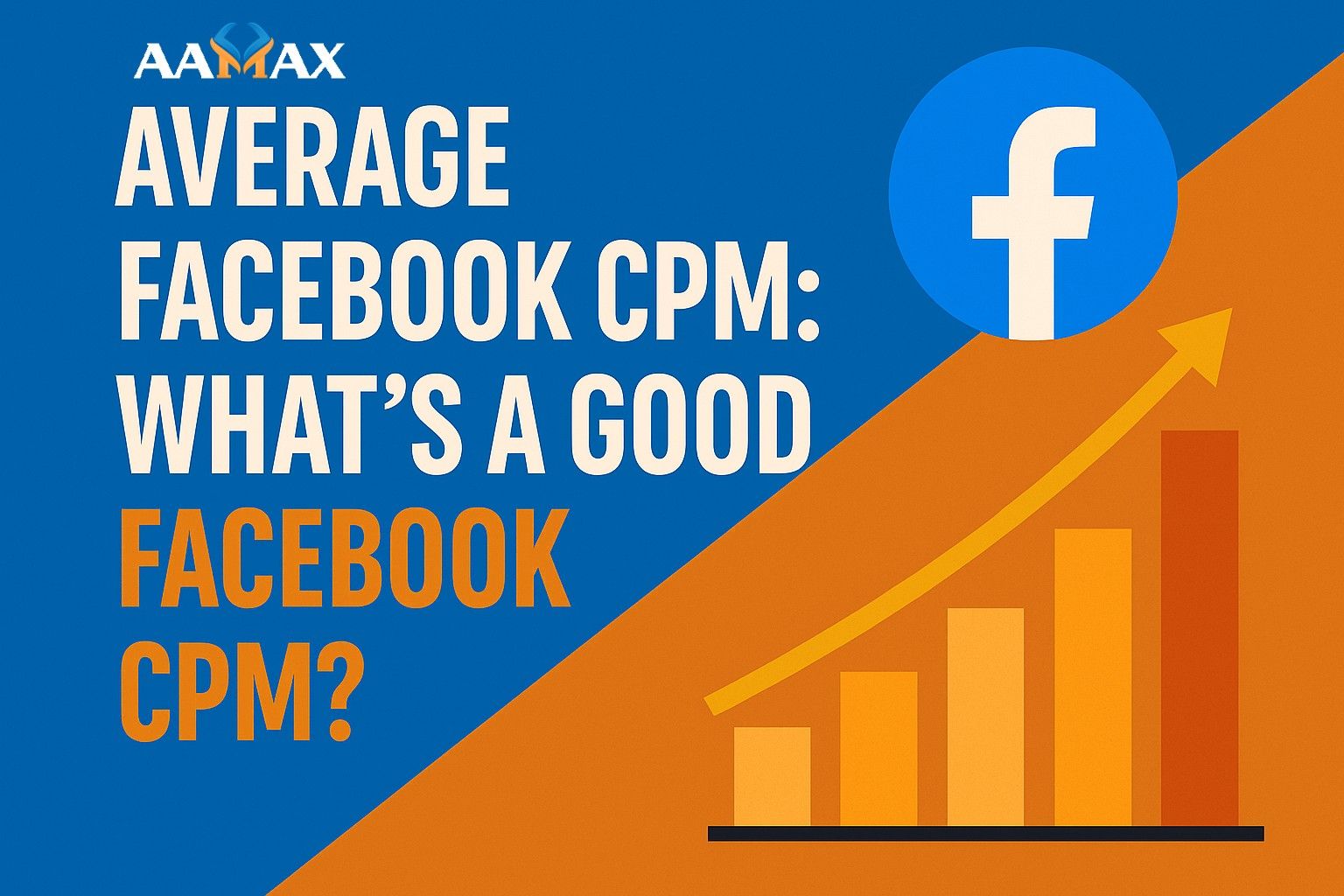
Average Facebook CPM: What’s a Good Facebook CPM?
CPM is an essential metric because it directly affects how much you pay to get your ads seen and, ultimately, how cost-effective your campaigns are.
Why Does CPM Matter in Facebook Ads?
Facebook Ads are auction-based. Advertisers bid for ad placements, and CPM helps measure the cost-effectiveness of these bids.
Here's why CPM is so crucial:
-
Budget planning: Knowing your CPM helps you predict how many people your budget can reach.
-
Comparing campaigns: CPM allows you to compare costs across different audiences, ad creatives, and placements.
-
Performance insight: A rising CPM could signal increased competition, poor audience targeting, or creative fatigue.
Understanding CPM empowers you to make data-driven decisions and avoid overspending.
What’s the Average Facebook CPM?
The average Facebook CPM varies widely based on several factors, including industry, target audience, location, seasonality, and ad quality. For expert help, visit the best site for digital marketing and SEO services: AAMAX.
However, based on industry data, the average Facebook CPM usually ranges from $5 to $15 USD. Here are some key points:
-
Retail and eCommerce: CPMs typically range between $6–$12.
-
Financial services and insurance: Higher competition means CPMs can exceed $20.
-
B2B: Often falls in the $8–$15 range.
-
Entertainment and gaming: Usually lower, around $3–$8.
Remember, these are averages. Your actual CPM may be higher or lower depending on your specific targeting and campaign setup.
What’s a Good Facebook CPM?
A "good" CPM depends entirely on your industry, objectives, and location. However, here are some general guidelines:
-
For broad awareness campaigns, a CPM under $10 is often considered good.
-
For highly targeted campaigns (e.g., niche B2B), a CPM up to $20 could still be acceptable if the campaign drives conversions.
-
For retargeting campaigns, CPMs tend to be higher, but the conversion rates justify the cost.
Ultimately, a good CPM should align with your return on ad spend (ROAS) and cost per acquisition (CPA).
Factors That Influence Facebook CPM
Facebook CPM isn’t fixed. Several factors affect your costs:
1. Audience Targeting
-
Broad audiences: Usually cheaper CPM due to more people in the auction.
-
Niche audiences: Higher CPM due to limited availability and higher competition.
2. Ad Relevance & Quality
Facebook scores your ads based on relevance and engagement. Better ads (higher click-through rates, positive feedback) get rewarded with lower CPM.
3. Competition and Demand
During high-demand periods (like holidays, Black Friday, or election season), more advertisers bid, driving up CPM.
4. Placement
Different placements have different CPMs:
-
News Feed: Higher CPM but more engagement.
-
Stories and Audience Network: Lower CPM, but sometimes lower engagement.
5. Geographic Location
Targeting audiences in countries like the US, Canada, or Western Europe tends to have higher CPMs than targeting audiences in Southeast Asia or Africa.
6. Time of Year
Seasonality plays a significant role. For example, Q4 (October to December) typically sees a spike in CPM as brands increase ad spending.
How to Lower Your Facebook CPM
While CPM is partly influenced by external factors, you can take practical steps to reduce it.
Optimize Audience Targeting
-
Use lookalike audiences to expand reach without losing relevance.
-
Regularly refresh custom audiences to avoid saturation.
-
Avoid overlapping audiences, which can drive up competition and costs.
Improve Your Ad Creative
-
Test multiple ad formats: videos, carousels, images, etc.
-
Keep content fresh to combat ad fatigue.
-
Use compelling visuals and clear calls-to-action (CTAs).
Focus on Relevance and Engagement
-
Craft ads that resonate with your target audience.
-
Encourage likes, comments, and shares.
-
Monitor relevance diagnostics in Facebook Ads Manager.
Experiment with Placements
-
Use Automatic Placements to let Facebook find cheaper impressions.
-
Review placement performance data and adjust accordingly.
Bid and Budget Strategies
-
Try Campaign Budget Optimization (CBO) to let Facebook allocate budget effectively.
-
Consider different bid strategies, like cost cap or bid cap.
Schedule Ads Strategically
-
Run ads when your audience is most active.
-
Avoid running during peak competition periods unless necessary.
CPM vs. Other Facebook Metrics
CPM alone doesn’t tell the whole story. Here’s how it fits into broader campaign performance:
-
CPM vs. CPC (Cost Per Click): Low CPM doesn’t guarantee low CPC if your ad doesn’t drive clicks.
-
CPM vs. CPA (Cost Per Acquisition): Your goal might be to get conversions; a higher CPM can be fine if it leads to cheaper CPA.
-
CPM vs. ROAS: Focus on profitability. High CPM might still yield strong ROAS if your product margins are good.
Balance CPM with other key metrics to get a complete view.
Should You Always Aim for a Low CPM?
Not necessarily. A low CPM is appealing but isn’t always better. For example:
-
If your CPM drops because you're targeting a broader, less relevant audience, your CPA could rise.
-
A slightly higher CPM targeting a high-intent audience might result in better sales and ROAS.
The goal isn’t just cheap impressions—it’s valuable impressions that help achieve business objectives.
When to Reevaluate Your Facebook CPM
Watch your campaigns for signs that CPM may need attention:
- Sudden spikes in CPM without changes in audience or creative.
- CPM trends upwards while CTR and conversion rates drop.
- Seasonal changes cause predictable CPM increases—plan budgets accordingly.
By monitoring CPM trends, you can spot issues early and adapt your strategy.
Practical Tips for Beginners
If you're new to Facebook Ads, here are simple steps to manage CPM effectively:
-
Start with broad audiences, then narrow down based on data.
-
Test at least 3–4 creatives per ad set.
-
Analyze placement data, but don’t rush to limit placements.
-
Monitor relevance diagnostics weekly.
-
Adjust budgets gradually—sudden changes can disrupt learning phases.
Facebook CPM Benchmarks by Industry
Here’s a quick overview of average CPMs by industry (based on recent data):
To help you understand what might be considered average, here are some typical Facebook CPM ranges by industry:
-
Retail & eCommerce: $6–$12
-
Education & Training: $5–$10
-
Financial Services: $15–$25
-
Healthcare & Pharma: $8–$15
-
B2B: $8–$15
-
Entertainment & Gaming: $3–$8
These figures give a rough idea of what to expect. Your own CPM may vary depending on targeting, location, and creative quality.
Use these figures as reference points—not fixed targets. Your actual CPM will vary.
Need Help Managing Facebook CPM?
Facebook advertising is powerful, but mastering CPM and other metrics requires strategy, creative testing, and continuous optimization. If you'd rather focus on your business while experts handle your campaigns, consider hiring AAMAX.
AAMAX is a full-service digital marketing agency offering web development, digital marketing, and SEO services. From managing Facebook Ads to improving ROI across platforms, AAMAX helps businesses grow online.
Final Thoughts
To sum up, Facebook CPM tells you how much you pay per thousand ad impressions—a crucial metric for budgeting and evaluating campaign efficiency.
A "good" CPM depends on your audience, objectives, industry, and seasonality. Focus not just on lowering CPM, but on finding the right balance between cost and campaign effectiveness.
By understanding what influences CPM and how to manage it strategically, you'll be better prepared to run profitable Facebook campaigns that align with your goals.







